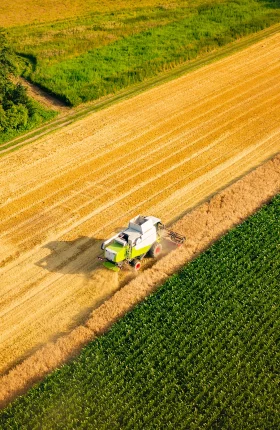Agricultural commodity traders are facing perhaps the most challenging market environment ever. As a result of ongoing competitive pressures in the agriculture sector, along with advances in technology infrastructure and increasingly sophisticated producers and off-takers, the trading market has become increasingly liquid, transparent, and competitive. Given competitive pressures in the midstream sector, these developments are likely to continue for quite some time, unless the markets experience strong disruptions in supply and demand.
comm
To succeed in the tightening trading environment, traders and other market participants need to sharpen and reinforce their competitive edge—in some cases, even reinventing the way they do business. For other players in the value chain, such as farmers and large consumers, the lower barriers to market entry present a significant growth opportunity. In what is essentially a more “commoditized” trading environment, these companies can go far—so long as they can leverage their competitive advantage and modernize their commercial skill set.
A Convergence of Challenges
The challenges confronting agricultural commodity trading are nothing new. Prices of agricultural commodity products, which began spiraling steadily downward in 2012, have stabilized at a comparatively low level over the past few years. (See Exhibit 1.)
These pricing pressures, in combination with higher operating and production costs, have hurt the performance of most producers (farmers and cooperatives) and many off-takers (especially food processers and distributors). Returns declined from 2012 to 2017, making all market participants more cost-conscious—and more focused on price differentiation for their goods.
Developments in other parts of the agriculture value chain have contributed to commodity traders’ challenges. As the fortunes of the agriculture industry have declined, farmers have taken various steps to protect themselves. Those who traditionally engaged in a wide range of activities have started narrowing their focus to secure profits. Some have stopped dairy farming altogether and limited the number of crops that they grow. Others have engaged in M&A, resulting in larger farms and giving cooperatives more bargaining power. Many have built up their own logistics and processing capabilities in order to time the sale of their products to higher prices.
Digital developments, too, are having a major impact on trading markets. The number of comprehensive platforms and B2B online stores has risen dramatically over the past decade, making commodity prices even more transparent and arbitrage opportunities scarcer. In all likelihood, commercial transactions will become increasingly digital. Wielding just a smartphone, farmers will be able to enter the current price for their products and have buyers pick them up directly, completely removing traders from the exchange.
Irreversible Impacts
In our view, these trends can’t be reversed without a distinct external disruption. In fact, there are reasons to believe that the market power of large farmers and cooperatives, and of off-takers, will only continue to grow relative to that of commodity traders.
Farmers are getting more and more commercially and operationally sophisticated, and that’s likely to continue. This is not just a matter of quick access to market data and other information. BCG predicts that the adoption of precision farming—the use of data to ensure that crops and soil get exactly what they need for optimal health and productivity—will become prevalent. (See Crop Farming 2030: The Reinvention of the Sector, BCG Focus, April 2015.) As crops and inputs keep improving, farms will gain more control over their own supply chains.
There are reasons to believe that the market power of large farmers and cooperatives will only continue to grow relative to that of commodity traders.
Commodity traders are taking steps to protect themselves. Some have integrated across the value chain, investing in logistics (storage), secured positions (off-take and supply), processors (crushers), and distribution (trucks) assets so that they can sit out periods when commercial margins are low. At the same time, large companies like COFCO have made acquisitions, resulting in the concentration of a few large firms with massive amounts of market power. But for companies that sit idly by, success is anything but guaranteed.
What Agricultural Commodity Players Need to Do Now
In light of these developments, all the key players in the agriculture value chain—traditional merchants and distributors as well as nontraders (large farmers, food processors, packagers, and retailers)—need to rethink the way they do business. For traders and nontraders alike, there are opportunities to expand into adjacent parts of the value chain. (See Exhibit 2.)
Traditional Merchants and Distributors. Many midstream players are likely facing the greatest challenges they’ve ever seen. To survive and thrive, they need to sharpen their competitive edge. Four practices are especially important:
- Ensure a lean cost base. With margins under intense pressure, traders need to scrutinize their costs more closely than ever. They first should assess their cost/gross-margin ratio to make sure that costs are not too high relative to profits. Given the increase in the level of automation and digital processing, it’s also important to ensure that the operational platform processes physical flows and trade transactions as efficiently as possible. But we are not advocating across-the-board cost reductions. There’s no point in making cuts that compromise the effectiveness of processes critical to competitive advantage.
-
Push the portfolio harder. As success in the midstream segment gets more challenging, trading firms must make an honest assessment of the profitability of their different business and commodity lines. If declining profits are an issue, they need to do more than divest the least profitable lines. Rather, they need to determine if they are in the right markets and adapt their portfolios accordingly. It also means trying out sophisticated trading strategies, including dynamic trading, trading around assets, and digitally enhanced strategies leveraging the wealth of data at companies’ disposal.
Large companies must think clearly about where to play, where to build a competitive edge, and, therefore, where to originate. They need to determine whether and how to expand their footprint into regions like Asia, where demand is growing quickly, as opposed to Europe and North America, where growth is flat. Smaller firms should assess their market share in each segment and region. If it isn’t substantial enough to compete, they can consider M&A and partnerships.
-
Lock in logistics advantages. It’s also critical to identify the key sources of competitive advantage. That means assessing port/terminal, elevation, and rail transport capacity to understand how they contribute to the bottom line. In addition to reducing transaction costs, these assets provide flexibility and access—that is, the ability to exploit a variety of short-term market opportunities.
For the lines that are the most profitable, firms would be well advised to reinforce proprietary access to logistics, control of flows, and scale. They should also stress-test their balance sheet to make sure they will be able to make the kinds of logistics expenditures that may be needed down the road.
- Understand the potential for generating additional revenues. Companies also need to assess the uplift they can get from entering adjacent or new commodity trading markets. This requires estimating the additional value that could be generated by leveraging existing logistics and larger portions of the end-to-end flow.
Many midstream players are likely facing the greatest challenges they’ve ever seen.
Given current margin pressures and market volatility, it’s a good idea to adjust the risk profile so the balance sheet can support it. Reducing the risk in some trading strategies may be necessary. In cases where no sustainable risk-return profile is feasible, firms should consider partially switching to fee-based service and support models.
Nontraders. The pressure on midstream traders and the lower barriers to entry have opened up major growth opportunities for upstream and downstream players. Producers and off-takers need to leverage their emerging competitive edge to enter the trading and risk management space and create value beyond their base business.
But this is not a decision to make lightly. The investment for outsiders is considerably greater than it is for insiders. The costs can run anywhere from single- to double-digit millions, depending on existing commercial capabilities and whether joint ventures or M&A is necessary. And because it is a whole new undertaking that requires companies to be more commercially driven, it necessitates a major change in governance and organizational culture. We recommend that companies first do the following:
- Evaluate current market strength and the company’s commercial approach. Producers and large off-takers alike should assess whether the dramatic changes in the market environment have helped or hurt their business, and whether the current portfolio is compelling enough to engage in more trading activities. They also need to determine how their commercial capabilities measure up. If competitors have a more sophisticated commercial and risk management approach, producers and off-takers will have to take it up a notch. This includes building commodity trading and risk management systems for monitoring and managing price exposure. The decision to change the commercial approach must be backed up by a strong business case. Judgment alone is not enough.
- Develop management and performance tools. It’s advisable for prospective players to create the tools and capabilities needed to understand how exposed their business would be to price and therefore cash and earnings volatility if they expanded into trading.
- Take an end-to-end view of the value chain. Many agriculture companies, especially producers, follow a functional approach in their organization. But as markets mature, players need to take an end-to-end margin and optimization view of the value chain. Integrated margin management is essential for ensuring that input and output price levels are aligned. It also helps players leverage embedded optionalities.
- Deploy risk protection. Players must then assess from a risk perspective what they need to do to protect their business. In particular, this means analyzing the benefits of actively managing risk exposure to see if it would better protect the value of their underlying assets and flows. Some players may also start using a hedging program to limit the potentially adverse effects of market price development. As with the value chain, it’s critical to deploy an end-to-end view of risk. Only by looking at input and output prices together under a market price regime is it possible to synchronize price management.
Embarking on Transformation
After making the decision to participate more in trading and active risk management, companies should assess what they need to do operationally and culturally.
When it comes to trading, many producers and off-takers have limited, if any, commercial capabilities. Given the difficulty of building them in today’s environment, players need to consider inorganic options like partnerships, joint ventures, and acquisitions, as well as strategic hiring, to bring in the necessary capabilities.
The chief reason why entering and advancing the trading space is a big undertaking is that it requires a distinctly different culture. The portion of the organization that’s engaged in commercial activities needs to have a trading mindset, focused on pushing sales, comfortable with taking risks, and able to make big decisions quickly. For insiders, this mindset is baked in; for outsiders, it’s perhaps the biggest barrier they face.
Given the increasing sophistication and scale needed to succeed, in all likelihood only the largest players in each segment will survive the perilous trading environment. Even so, transformation of some type will be critical. Insiders will need to enhance their capabilities to fortify their position, while outsiders that are able to expand into trading will need to make significant operational and cultural changes. No matter where a company sits on the value chain, inactivity is not an option.








